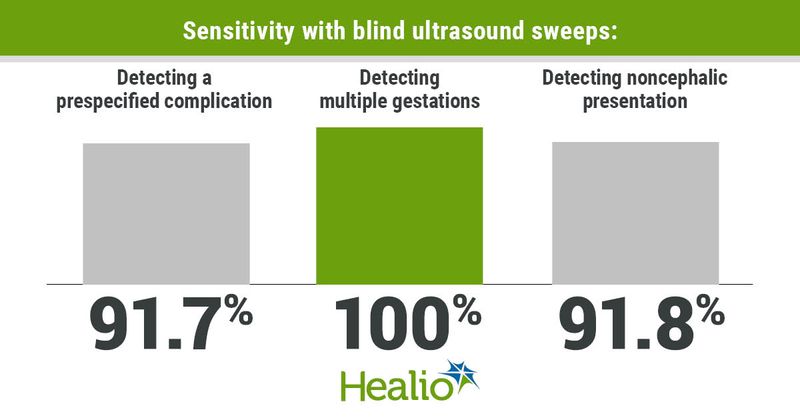Blind ultrasound sweeps with low-cost, portable device identify high-risk pregnancies
Key takeaways:
- Sensitivity for detecting a prespecified complication was 91.7% using a low-cost, portable, battery-powered device.
- The highest detection rate was observed for multiple gestations and noncephalic presentation.
Blind ultrasound sweeps performed by operators without formal training using a low-cost, portable, battery-powered device resulted in high sensitivity and specificity for high-risk pregnancy complications, according to study findings.
To eliminate barriers to widespread ultrasonography, one solution is volume sweep imaging with a portable, low-cost ultrasound system plus telemedicine for remote interpretation by an offsite trained specialist or artificial intelligence, researchers wrote in Obstetrics & Gynecology. This strategy uses blind sweeps of the ultrasound probe guided by external anatomic landmarks to direct transducer movements and can be performed by operators without prior medical knowledge with brief training.

“This type of protocolized blind sweep obstetric ultrasound examination has been tested previously in individuals with normal, uncomplicated pregnancies,” Marika Toscano, MD, MS, assistant program director and assistant professor in the division of maternal-fetal medicine in the department of gynecology and obstetrics at Johns Hopkins University School of Medicine, and colleagues wrote. “Here, we built on these studies by using this technology to identify pregnancies with abnormalities.”
This single-center, prospective cohort study included 168 women with second- and third-trimester pregnancies from October 2020 to January 2022. Nonspecialists with no prior formal ultrasound training underwent a brief training program on a simple eight-step approach to performing a limited obstetric ultrasound examination using blind sweeps of a portable ultrasound probe using external landmarks. These blind sweeps were interpreted by five blinded maternal-fetal medicine subspecialists.
The primary outcome was identification of pregnancy complications, including fetal malpresentation, multiple gestations, placenta previa and abnormal amniotic fluid volume.
Overall, 194 blinded ultrasound examinations were performed with a total of 1,552 blinded sweep cine clips. Trainees conducted 49 ultrasonograms with normal pregnancy results and 145 ultrasonograms with abnormal pregnancy results with known complications.
Of women with abnormal pregnancy results, sensitivity for detecting a prespecified complication was 91.7%, with the highest detection rate of 100% for multiple gestations and 91.8% for noncephalic presentation. Researchers observed a high negative predictive value of 96.1% for detecting placenta previa and 89.5% for abnormal amniotic fluid volume.
In addition, researchers noted a substantial to perfect mean agreement for these same pregnancy complication outcomes, ranging from 87% to 99.6%, according to researchers.
“Closing the gap of the significant health care disparities in obstetrics will require new and innovative strategies,” the researchers wrote. “Obstetric volume sweep imaging shows significant promise as a tool to diagnose pregnancy complications and merits further investigation and development.”

